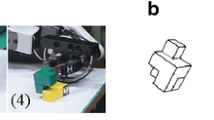Abstract
Assembly sequence planning is one of typical combinatorial optimization problems, where the size of parts involved is a significant and often prohibitive difficulty. The compact storage and efficient evaluation of feasible assembly sequences is one crucial concern. Ordered binary decision diagram (OBDD) is a canonical form to represent and manipulate the Boolean functions efficiently, and appears to give improved results for large-scale combinatorial optimization problems. In this paper, assembly knowledge models of liaison graph and translation function are formulated by OBDDs, and OBDD-based representation of assembly sequences is proposed. A novel OBDD-based procedure was presented to generate all geometrically feasible assembly sequences from the OBDDs of liaison graph and translation relation. This procedure can be used conveniently on the computer and all the feasible sequences can be derived. The great advantage of OBDD-based scheme is that the storage space of OBDD-based representation of feasible assembly sequences does not increase with the part count of assembly dramatically so quickly as that of AND/OR graph does. We developed the prototype tool for generating assembly sequence using Visual C++ and CUDD package, and undertake some experimental tests. It was shown that the OBDD scheme generated feasible assembly sequences correctly and completely.
Similar content being viewed by others
References
Bourjault A (1984) Contribution à une approche méthodologique de l’assemblage automatisé: élaboration automatique des séquences opératoires. Thèse d’ État. Université de Franche-Comté, Besancon, France
Wilson RH (1995) Minimizing user queries in interactive assembly planning. IEEE Trans Robotics Autom 11(2):308–311
Gottipolu RB, Ghosh K (2003) A simplified and efficient representation for evaluation and selection of assembly sequences. Comput Ind 50(3):251–264
Warrats JJ, Bonschancher N, Bronsvoort WF (1992) A semiautomatic sequence planner. In Proceedings of IEEE International Conference on Robotics and Automation, Nice, France, pp 2431–2438
Fazio De TL, Whitney DE (1987) Simplified generation of all mechanical assembly sequences. IEEE J Robotics Autom 3(6):640–658
Gottipolu RB, Ghosh K (2003) A simplified and efficient representation for evaluation and selection of assembly sequences. Comput Ind 50(3):251–264
Homem de Mello LS, Sanderson AC (1990) AND/OR graph representation of assembly plans. IEEE Trans Robotics Autom 6(2):188–199
Zhang W (1989) Representation of assembly and automatic robot planning by Petri net. IEEE Trans System, Man, Cybern 19(2):418–422
Homem de Mello LS, Sanderson AC (1991) Representation of mechanical assembly sequences. IEEE Trans Robotics Autom 7(2):211–227
Homem de Mello LS, Sanderson AC (1991) A correct and complete algorithm for the generation of mechanical assembly sequences. IEEE Trans Robotics Autom 7(2):228–240
Su Q (2007) Applying case-based reasoning in assembly sequence planning. Int J Prod Res 45(1):29–47
Yin ZP, Han D, Li HX, Xiong YL (2003) A connector-based hierarchical approach to assembly sequence planning for mechanical assemblies. Comput Aided Des 35(1):37–56
Marian RM, Luong LHS, Abkary K (2003) Assembly sequence planning and optimization using genetic algorithms. Appl Soft Comput 223–253
Wang JF, Liu JH, Zhong YF (2005) A novel ant colony algorithm for assembly sequence planning. Int J Adv Manuf Technol 25(11):1137–1143
Ning L, Gu T (2007) Immune algorithm for assembly sequence planning problem. Comput Integrated Manuf Syst 13(1):81–87
Bryant RE (1986) Graph-based algorithms for Boolean function manipulation. IEEE Trans Comput 35(8):677–691
Bryant RE (1992) Symbolic Boolean manipulation with ordered binary decision diagrams. ACM Comput Surv 24(3):293–318
Sieling D, Drechsler R (1993) Reduction of OBDDs in linear time. Inf Process Lett 48(1):139–144
Sieling D, Wegener I (1995) Graph driven BDDs—a new data structure for Boolean functions. Theor Comput Sci 141:283–310
Hachtel GD, Somenzi F (1997) A Symbolic algorithm for maximum flow in 0-1 networks. Formal Methods Syst Des 10(2/3):207–219
Gu T, Xu Z (2007) The symbolic algorithms for maximum flow in networks. Comput Oper Res 34(2):799–816
Edelkamp S, Reffel F (1998) OBDDs in heuristic search. In Proceedings of the 22nd Annual German Conference on Artificial Intelligence, pp 81–92
Edelkamp S, Helmert M (2001) MIPS: The model-checking integrated planning system. AI Mag 22(3):67–71
Cimatti A, Roveri M (2000) Conformant planning via symbolic model checking. J Artif Intell Res 13(0):305–338
Cimatti A, Pistore M, Roveri M, Traverso P (2003) Weak, strong, and strong cyclic planning Via symbolic model checking. Artif Intell 147:35–84
Bertoli P, Cimatti A, Roveri M, Traverso P (2006) Strong planning under partial observability. Artif Intell 170(4–5):337–384
Jensen RM, Veloso MM (2000) OBDD-based universal planning for synchronized agents in non-deterministic domains. J Artif Intell Res 13(0):189–226
Jensen RM, Veloso MM, Bryant RE (2007) State-set branching: leveraging BDDs for heuristic search. Artif Intell (available online)
Somenzi F, CUDD: CU Decision Diagram Package Release 2.3.1. http://vlsi.Colorado.edu/
Author information
Authors and Affiliations
Corresponding author
Rights and permissions
About this article
Cite this article
Gu, T., Liu, H. The symbolic OBDD scheme for generating mechanical assembly sequences. Form Methods Syst Des 33, 29–44 (2008). https://doi.org/10.1007/s10703-008-0052-y
Published:
Issue Date:
DOI: https://doi.org/10.1007/s10703-008-0052-y



